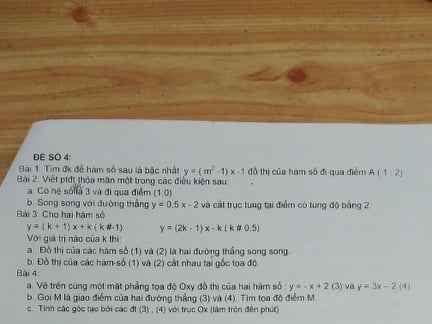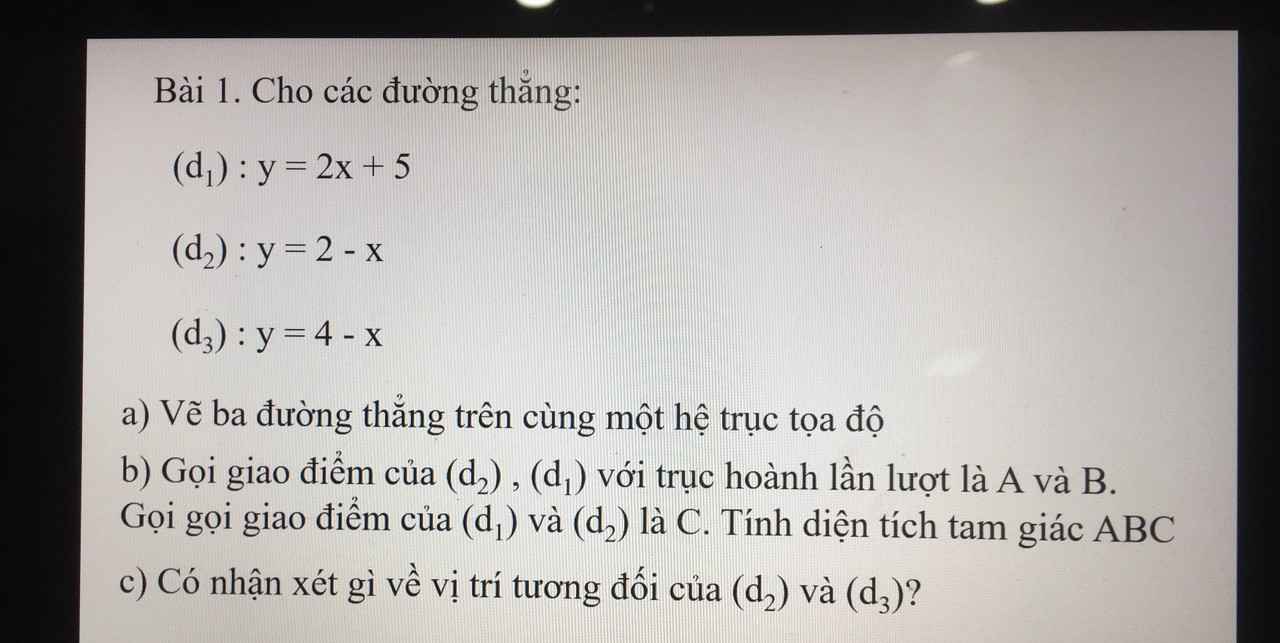
Hãy nhập câu hỏi của bạn vào đây, nếu là tài khoản VIP, bạn sẽ được ưu tiên trả lời.


Bài 2:
a: Vì (d) có hệ số góc là 3 nên a=3
Vậy: (d): y=3x+b
Thay x=1 và y=0 vào (d), ta được:
b+3=0
hay b=-3
b: Vì (d)//y=0,5x-2 nên a=0,5
Vậy: (d): y=0,5x+b
Thay x=0 và y=2 vào (d), ta được:
b=2




1: ĐKXĐ: x<>1 và y>=2
\(\left\{{}\begin{matrix}\dfrac{2}{x-1}-\sqrt{y-2}=-1\\\dfrac{3}{x-1}+2\sqrt{y-2}=9\end{matrix}\right.\)
=>\(\left\{{}\begin{matrix}\dfrac{4}{x-1}-2\sqrt{y-2}=-2\\\dfrac{3}{x-1}+2\sqrt{y-2}=9\end{matrix}\right.\Leftrightarrow\left\{{}\begin{matrix}\dfrac{7}{x-1}=7\\\dfrac{3}{x-1}+2\sqrt{y-2}=9\end{matrix}\right.\)
=>\(\left\{{}\begin{matrix}x-1=1\\2\sqrt{y-2}=9-3=6\end{matrix}\right.\)
=>\(\left\{{}\begin{matrix}x-1=1\\\sqrt{y-2}=3\end{matrix}\right.\Leftrightarrow\left\{{}\begin{matrix}x=2\\y-2=9\end{matrix}\right.\)
=>\(\left\{{}\begin{matrix}x=2\\y=11\end{matrix}\right.\left(nhận\right)\)
2:
a: Phương trình hoành độ giao điểm là:
\(x^2-\left(m-2\right)x-m-4=0\)
\(\text{Δ}=\left[-\left(m-2\right)\right]^2-4\left(-m-4\right)\)
\(=m^2-4m+4+4m+16\)
\(=m^2+20>=20>0\forall m\)
=>(d) luôn cắt (P) tại hai điểm phân biệt
b: Theo Vi-et, ta có:
\(\left\{{}\begin{matrix}x_1+x_2=-\dfrac{b}{a}=\dfrac{-\left[-\left(m-2\right)\right]}{1}=m-2\\x_1\cdot x_2=\dfrac{c}{a}=-m-4\end{matrix}\right.\)
\(\left|x_1+x_2\right|=\left|x_1-x_2\right|\)
=>\(\left[{}\begin{matrix}x_1+x_2=x_1-x_2\\x_1+x_2=-x_1+x_2\end{matrix}\right.\)
=>\(\left[{}\begin{matrix}-2x_2=0\\2x_1=0\end{matrix}\right.\Leftrightarrow x_1\cdot x_2=0\)
=>-m-4=0
=>m+4=0
=>m=-4

b, PTGD (d1) và trục hoành là \(2x+5=0\Leftrightarrow x=-\dfrac{5}{2}\Leftrightarrow B\left(-\dfrac{5}{2};0\right)\Leftrightarrow OB=\dfrac{5}{2}\)
PTGD (d2) và trục hoành là \(2-x=0\Leftrightarrow x=2\Leftrightarrow A\left(2;0\right)\Leftrightarrow OA=2\)
Do đó \(AB=OA+OB=\dfrac{9}{2}\)
PTHDGD (d1) và (d2) là \(2x+5=2-x\Leftrightarrow x=-1\Leftrightarrow y=3\Leftrightarrow C\left(-1;3\right)\)
Gọi H là chân đg cao từ C tới Ox thì \(CH=3\)
Do đó \(S_{ABC}=\dfrac{1}{2}CH\cdot AB=\dfrac{1}{2}\cdot\dfrac{9}{2}\cdot3=\dfrac{27}{4}\left(đvdt\right)\)
c, Vì \(-1=-1;2\ne4\) nên (d2)//(d3)

a: Ta có: \(A=\left(\dfrac{1}{\sqrt{x}+1}-\dfrac{1}{x+\sqrt{x}}\right):\dfrac{x-\sqrt{x}+1}{x\sqrt{x}+1}\)
\(=\dfrac{x-1}{\sqrt{x}\left(\sqrt{x}+1\right)}\cdot\dfrac{\sqrt{x}+1}{1}\)
\(=\dfrac{x-1}{\sqrt{x}}\)
b: Để A<0 thì x-1<0
hay x<1
Kết hợp ĐKXĐ, ta được: 0<x<1
với \(x\ge0\) ta có :\(D=\dfrac{3\sqrt{x+7}}{\sqrt{x}+2}=\dfrac{3\left(\sqrt{x}+2\right)+1}{\sqrt{x}+2}=3+\dfrac{1}{\sqrt{x}+2}\)
D lớn nhất \(\Leftrightarrow\sqrt{x}+2\) nhỏ nhất:
Mà:\(\sqrt{x}+2\ge2\)
vậy:\(\max\limits_D=3+\dfrac{1}{2}=\dfrac{7}{2}\Leftrightarrow x=0\)




 GIẢI HỘ EM BÀI 3 VỚI Ạ
GIẢI HỘ EM BÀI 3 VỚI Ạ


